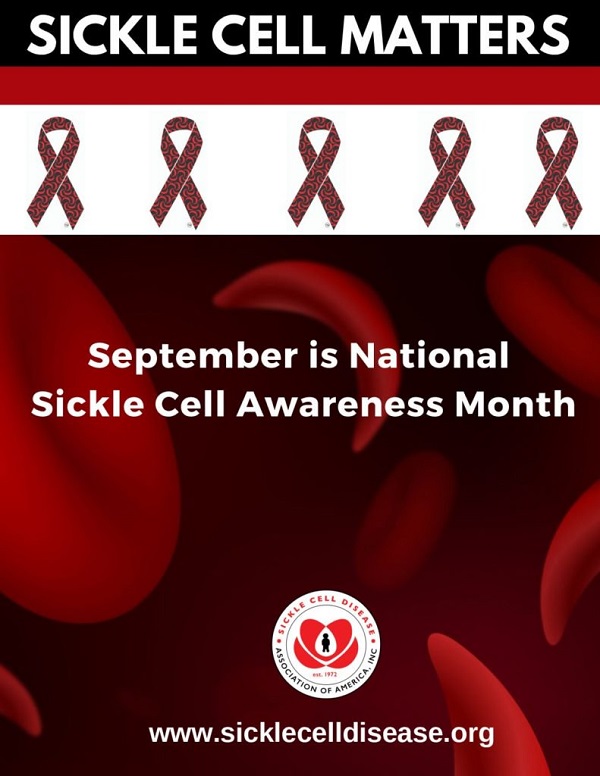 Sickle cell disease (SCD) or sickle cell anemia is a severe autosomal recessively inherited disorder in which red blood cells become sickle- or crescent-shaped and harden. According to the Sickle Cell Disease Association of America Inc., this sickle-shaped blood cell can block blood flow through the body and can lead to serious problems including anemia, stroke, fatigue, swelling in extremities, delayed growth, vision problems/blindness, frequent infections, lung tissue damage, kidney disease, shortened life expectancy, damage to hip joints, and episodes of pain called “pain crises.” SCD can be very painful, emotionally distressing, debilitating, and deadly, which is why there is a need for education around understanding this disease.
Sickle cell disease (SCD) or sickle cell anemia is a severe autosomal recessively inherited disorder in which red blood cells become sickle- or crescent-shaped and harden. According to the Sickle Cell Disease Association of America Inc., this sickle-shaped blood cell can block blood flow through the body and can lead to serious problems including anemia, stroke, fatigue, swelling in extremities, delayed growth, vision problems/blindness, frequent infections, lung tissue damage, kidney disease, shortened life expectancy, damage to hip joints, and episodes of pain called “pain crises.” SCD can be very painful, emotionally distressing, debilitating, and deadly, which is why there is a need for education around understanding this disease.
According to this National Library of Medicine article, there have been some positive medical breakthroughs in Hematopoietic Stem Cell Transplantation and bone marrow transplant; however, bone marrow transplants are very risky procedures that can have serious side effects, including death.
Diagnosis of SCD can be determined with a blood test which is now a routine screening for newborns. Most affected babies start showing signs of SCD around 5 months to 1 year of age. There are several forms of SCD, and symptoms are unique to everyone; pain can range from mild to severe. Despite SCD being an awful disease, people who have SCD can live full lives and enjoy activities that most other people do.
According to the CDC, to inherit SCD, both parents must carry sickle cell trait (SCT or HbAS). Sickle cell trait cannot become sickle cell disease. Although rare, some people with SCT can experience pain crises which can be caused by increased pressure in the atmosphere, low oxygen levels, dehydration, and experiencing high altitudes.
So, what is my interest in SCD? I myself have SCT. This diagnosis means that if I have a child with someone who also has SCT, there is a 50% chance that our child may inherit SCT and a 25% chance that our child could be born with SCD – it is a pretty scary thought to possess and process.
Over the years of researching SCD, I have learned that SCT began in places where malaria was most common, such as Africa, South Asia, and South America. SCT has a protective effect against malaria. Long story short, those of us with SCT cannot get malaria, which would be helpful to me if I lived in the Amazon where malaria is rampant, but I do not. In the United States, SCD/SCT occurs predominately in African Americans; however, people of different ethnic backgrounds can carry the trait or possess this disease.
You may be wondering, “Do I know of anyone with SCD?” My answer to you is yes! Below is a list of celebrities with sickle cell disease:
- Tionne “T-Boz” Watkins, R&B singer, TLC
- Prodigy, rapper, Mobb Deep
- Tiki Barber, running back, New York Giants
- Miles Davis, jazz trumpeter and composer
- Lalah Hathaway, R&B and jazz singer
- Tito Puente, Latin jazz bandleader and percussionist
- Tamera Mowry-Housley, actress and television personality
So, what can you do to inform yourself about SCD/SCT? Check out these resources below to get educated.
- Sickle Cell Awareness Month Fact Sheet
- 5 Facts You Should Know About Sickle Cell Disease
- Steps to Better Health for People with Sickle Cell Disease Toolkit
- Tips for Supporting Students with Sickle Cell Disease
- 9 Tips to Living Well with SCD in College
- What You Should Know About Sickle Cell Trait
- Get Screened for Sickle Cell Trait
—Dhy Edwardsberry, business librarian, Goizueta Business Library
